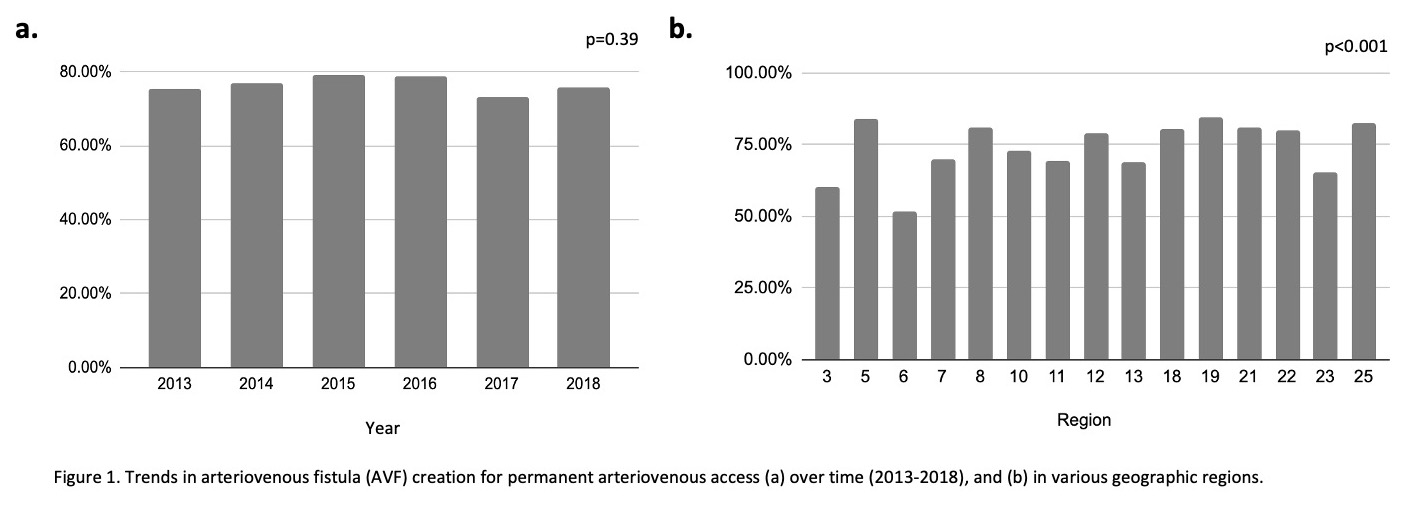A National Analysis Of The Creation Of Arteriovenous Fistulas Versus Grafts As Primary Access In Octogenarians: Current Trends And Implications On Outcomes
Shivee Gilja, BS, Arvind Kumar, BS, Kenneth R. Nakazawa, MD, Ajit G. Rao, MD, Rami O. Tadros, MD, Windsor Ting, MD, Peter L. Faries, MD, Ageliki G. Vouyouka, MD.
Icahn School of Medicine at Mount Sinai, New York, NY, USA.
OBJECTIVES: Although “Fistula First” has been touted in planning hemodialysis access, few studies have demonstrated that octogenarians benefit from this approach. We evaluated trends as well as short- and long-term outcomes for arteriovenous fistulas (AVFs) and arteriovenous grafts (AVGs) amongst octogenarians in a large-scale study.
METHODS: Outcomes of patients who received first-time AVF- versus AVG-creation from 2013 to 2018 were evaluated using the Vascular Quality Initiative Hemodialysis Registry. Univariate analysis and propensity score matching were used to compare access types, factoring in 26 pre- and peri-operative covariates.
RESULTS: From 2013 to 2018, 2,590 octogenarians underwent AVF-creation 76.6% (n=1,983) or AVG-creation 23.4% (n=607) for hemodialysis. Over time, rates of AVF creation for permanent AV access have remained stable (p=0.39, Fig1a). However, regional rates of AVF creation vary considerably, from 51.5% to 84.4% (p<0.00, Fig 1b). Patients with fistulas were younger, and less likely to be female or black. A propensity-score matched analysis, well-matched on all baseline covariates, yielded a cohort of 290 patients (145 in each arm). Three-year survival was 61.5% (matched analysis: 54.3%) for those who received AVG and 65.7% (matched analysis: 62.8%) to those who received AVF (univariate: p=0.079; matched analysis: p=0.078). When compared to AVG, AVF was associated with lower 30-day mortality (2.9% vs. 6.4%, p<0.001), however, this difference dissipated in matched groups (3.5% vs. 9.0%, p=0.052). Patients with AVFs also had lower complication rates (5.4% vs. 12.1%, p<0.001), which too was attenuated in matched analysis (7.7% vs. 15.0%, p=0.077). Conversely, AVF was associated with lower successful cannulation rates for dialysis (univariate: 44.7% vs. 63.6%, p<0.001; matched analysis: 41.5% vs. 57.7%, p=0.010) a higher time to cannulation (univariate: 316d vs. 143d, p<0.001; matched analysis: 307.5d vs. 129d, p=0.007). Patients with AVFs also underwent earlier secondary interventions in both unmatched (330d vs. 364.5d, p<0.001) and matched groups (303d vs. 377d, p=0.002).
CONCLUSIONS: This analysis suggests that there is significant regional variability regarding AVF creation over AVGs in octogenarians. While AVFs present with certain advantages, lower successful cannulation rates, longer time to successful cannulation, and earlier re-interventions, may be of special importance in this population with overall poor 3-year survival. 
Back to 2021 Karmody Posters
